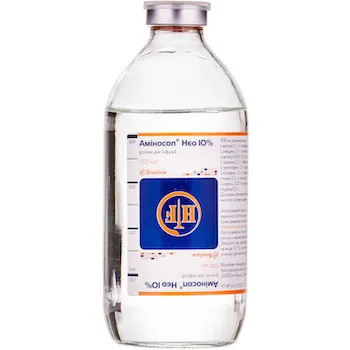Description
Aminosol NEO 10% 500 ml. №1 Vial
Composition
Aminosol NEO 10% 500 ml. №1 Vial contains a balanced combination of essential and non-essential amino acids, vitamins, and minerals crucial for various metabolic functions in the body.
Mechanism of Action
Pharmacologically, Aminosol NEO 10% 500 ml. №1 Vial provides essential nutrients that play a vital role in maintaining cellular function and tissue repair. The amino acids present in the solution are the building blocks of proteins, necessary for various physiological processes.
Indications for Use
Aminosol NEO 10% 500 ml. №1 Vial is indicated for patients requiring parenteral nutrition support to meet their amino acid and nutrient requirements.
Contraindications
Do not use Aminosol NEO 10% 500 ml. №1 Vial if there is a known allergy to any of the ingredients. Caution is advised in patients with severe renal impairment.
Side Effects
Clinical trials have demonstrated the efficacy of Aminosol NEO 10% 500 ml. №1 Vial in improving nitrogen balance and promoting wound healing in patients with severe protein-energy malnutrition. The balanced composition of amino acids and micronutrients in the solution contributes to its therapeutic benefits.
Usage Instructions
The recommended dosage of Aminosol NEO 10% 500 ml. №1 Vial is determined by a healthcare professional based on individual needs and the specific condition being treated. It should be administered intravenously as directed by a healthcare provider. It is essential to follow proper aseptic techniques during administration.
Benefits Compared to Analogues
Studies have shown that the amino acid profile in Aminosol NEO 10% 500 ml. №1 Vial can support protein synthesis and metabolic functions in critically ill patients.
Suitable Patient Groups
Aminosol NEO 10% 500 ml. №1 Vial is suitable for patients requiring parenteral nutrition support, including critically ill patients, individuals with severe protein-energy malnutrition, and those with specific amino acid and nutrient requirements.
Storage and Shelf Life
Aminosol NEO 10% 500 ml. №1 Vial should be stored according to the manufacturer’s instructions, typically at controlled room temperature. Check the expiration date on the packaging and do not use if expired.
Packaging Description
The product is packaged in a single-use vial containing 500 ml of Aminosol NEO 10% solution. Each vial is labeled with the necessary information regarding composition, dosage, and manufacturer details.





